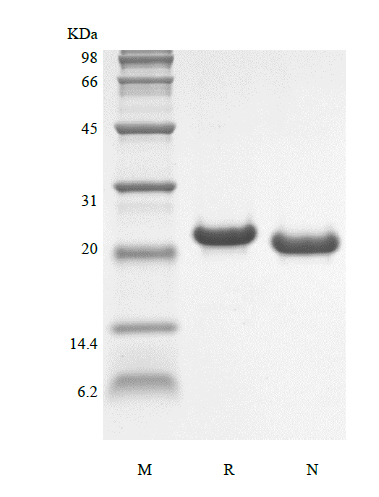订购信息
| 货号 | 描述 | 规格 | 单价/元 |
| X13239-10ug | Recombinant Murine Interleukin-6(IL-6)重组鼠白细胞介素-6 | 10ug | 2045 |
| X13239-100ug | Recombinant Murine Interleukin-6(IL-6)重组鼠白细胞介素-6 | 100ug | 7478 |
| X13239-500ug | Recombinant Murine Interleukin-6(IL-6)重组鼠白细胞介素-6 | 500ug | 16778 |
- Synonyms
- B-cell hybridoma growth factor, Interleukin HP-1.
- Accession
- P08505
- GeneID
- 16193
- Source
- Escherichia coli.
- Molecular Weight
- Approximately 21.7 kDa, a single non-glycosylated polypeptide chain containing 188 amino acids.
- AA Sequence
- MFPTSQVRRG DFTEDTTPNR PVYTTSQVGG LITHVLWEIV EMRKELCNGN SDCMNNDDAL AENNLKLPEI QRNDGCYQTG YNQEICLLKI SSGLLEYHSY LEYMKNNLKD NKKDKARVLQ RDTETLIHIF NQEVKDLHKI VLPTPISNAL LTDKLESQKE WLRTKTIQFI LKSLEEFLKV TLRSTRQT
- Purity
- > 97 % by SDS-PAGE and HPLC analyses.
- Biological Activity
- Fully biologically active when compared to standard. The ED50 as determined by the dose-dependent stimulation of the proliferation of IL-6-dependent murine 7TD1 cells is less than 0.02 ng/ml, corresponding to a specific activity of > 5 × 107 IU/mg.
- Physical Appearance
- Sterile Filtered White lyophilized (freeze-dried) powder.
- Formulation
- Lyophilized from a 0.2 μm filtered solution in 30 mM Acetic Acid, pH 3.0, 150 mM NaCl, 5 % Trehalose, 0.02 % Tween-20.
- Endotoxin
- Less than 1 EU/µg of rMuIL-6 as determined by LAL method.
- Reconstitution
- We recommend that this vial be briefly centrifuged prior to opening to bring the contents to the bottom. Reconstitute in sterile distilled water or aqueous buffer containing 0.1 % BSA to a concentration of 0.1 mg/mL. Stock solutions should be apportioned into working aliquots and stored at ≤ -20 °C. Further dilutions should be made in appropriate buffered solutions.
- Stability & Storage
-
Use a manual defrost freezer and avoid repeated freeze-thaw cycles.
- 12 months from date of receipt, -20 to -70 °C as supplied.
- 1 month, 2 to 8 °C under sterile conditions after reconstitution.
- 3 months, -20 to -70 °C under sterile conditions after reconstitution. - Usage
- This material is offered by xybio for research, laboratory or further evaluation purposes. NOT FOR HUMAN USE.
- SDS-PAGE
-

- Reference
-
1. Ferguson-Smith AC, Chen YF, Newman MS, et al. 1988. Genomics. 2:203-8.
2. van der Poll T, Keogh CV, Guirao X, et al. 1997. J Infect Dis. 176:439-44.
3. Ming JE, Cernetti C, Steinman RM, et al. 1989. J Mol Cell Immunol. 4:203-11; discussion 211-2.
4. Bastard JP, Jardel C, Delattre J, et al. 1999. Circulation. 99:2221-2.
5. Heinrich PC, Behrmann I, Muller-Newen G, et al. 1998. Biochem J. 334 ( Pt 2):297-314.
6. Van Snick J, Cayphas S, Szikora JP, et al. 1988. Eur J Immunol. 18:193-7.
- Background
- Interleukin-6 (IL-6) encoded by the IL-6 gene, acts as both a pro-inflammatory and anti-inflammatory cytokine. It is secreted by T cells and macrophages to stimulate immune response. It plays an essential role in the final differentiation of B-cells into Ig-secreting cells involved in lymphocyte and monocyte differentiation. It also induces myeloma and plasmacytoma growth and induces nerve cells differentiation acts on B-cells, T-cells, hepatocytes, hematopoietic progenitor cells and cells of the CNS. The mouse IL-6 is a single non-glycosylated polypeptide chain containing 187 amino acids and it signals through a cell-surface type I cytokine receptor complex consisting of the ligand-binding IL-6Rα chain (CD126), and the signal- transducing component gp130 (also called CD130). The mouse IL-6 shares 40 % and 85 % a.a. sequence identity with human and rat IL-6 and it is equally active on human and rat cells.








